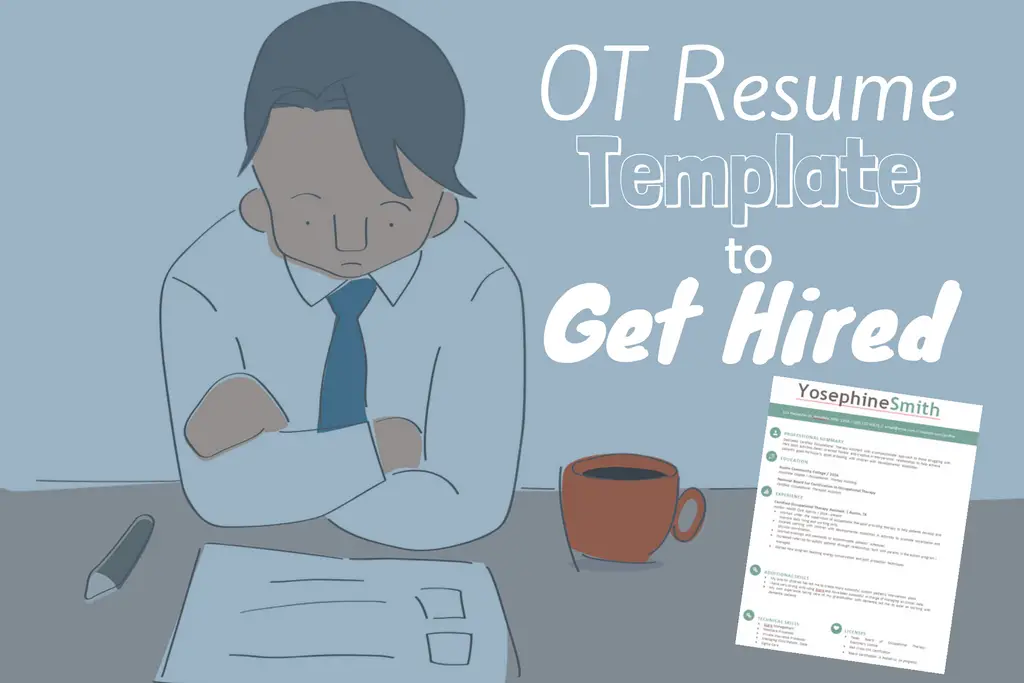
It is no secret that job opportunities for OTR and COTA professionals are growing rapidly. (27% job growth for OTR and 40% job growth for COTA when the US average is 7%)
But creating the perfect occupational therapy resume to land these job opportunities – still seems to be a secret.
After reviewing hundreds of OT resumes for OTR and COTA professionals, we put together this article and free template to share the most important elements to incorporate into your occupational therapy resume.
Using our template and these resume tips will help you get your resume in front of more recruiters and selected for more interviews.

We found that employers are overwhelmed with resume templates that all look the same and are full of the same content.
We also learned that when they receive one that stands out, in design and or content, that candidate has a much better chance of being marked as a good job candidate.
So, in addition to offering advice on creating the best OT resume to get found and selected by recruiters, we are actually going to give away a free resume template designed for occupational therapy professionals.
This template will give you a great starting point, then you just need to fill it in with all of your stellar experience, using our resume tips and keywords to get found by recruiters 🙂
[sociallocker id=”10518″]
Contents
Download OT Resume Template Files
The download includes a Word Doc for Windows users and a Pages doc for Mac users. Also included is the special font kit and installation instructions, this is required for the icons in the resume.
[/sociallocker]
So, without further ado, let’s get started building you an OT resume that is sure to get noticed!
Article Index:
- OT Resume Formatting
- Common Resume Content
- Exceptional Resume Content
- OT Accomplishments
- Additional Skills
- Keywords for Submitting Resume Online
- Telling Your Story Through Your Resume
OT Resume Formatting and Design
We won’t spend too much time on the layout of your OT resume but it is important to keep a few things in mind.
The main issue we see with resume formatting is that the text is cluttered. We understand it may be hard to fit all of your resume content into such a small space and so few words but it is important to have it formatted in a way that is readable.
Here is an example of an OT resume that is very cluttered, take note of the large blocks of text crammed together.
Does this look easy to read?
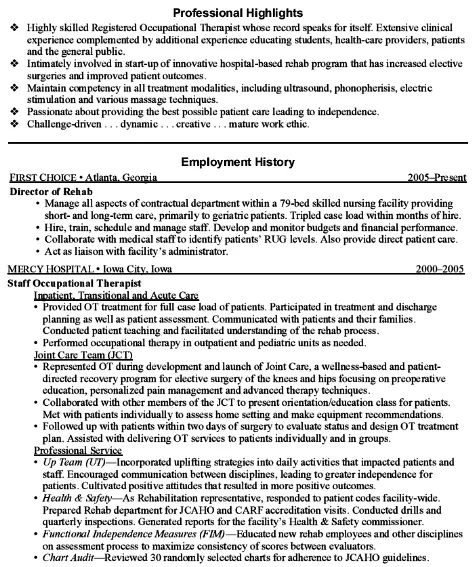
The resume is almost just one huge block of text.
This is how my first resume looked as well out of college. I basically tried to jam pack every sentence I could and as a result had a page that wasn’t laid out into sections very well and all ran together.
So, the first tip is to make sure to edit your content and layout so that you can include all the necessary info in your content without cluttering the design of the resume.
Here is a much better formatted occupational therapist’s resume. Notice the layout includes sections with a bit more space and clear bullet points both making the text much easier to read.

Much better!
The sections in this resume template provide just enough white space throughout the text making it easy to read.
The good news is, we are giving away an awesome free occupational therapy resume template that is formatted beautifully and is extremely readable.
But if you choose to use your own resume template, just remember to format it with sections and make the text readable.
The only other formatting and layout advice that you’ll need for creating your own resume template are which sections you’ll need to include.
Again, if you download our free OT resume template then don’t worry about this, but here are the most important sections that you will want to include if you create your own resume template:
- Professional Summary – Summarize yourself, your career status, and your OT experience.
- Licenses – State OTR/COTA licenses held along with any other certifications (first aid, CPR, etc)
- Skill Highlights – What are you specific skills, everything from beneficial personality traits to specific OT skills.
- Professional Experience – All occupational therapy intern, clinical, and full-time or part-time professional work experience.
- Education & Training – All of your education and continued education as an occupational therapy professional.
Pretty straight forward, right?
Believe it or not, that is it for resume layout and formatting.
You can either use our free OT resume template with all the formatting bells and whistles OR you can create your own using the tips and sections above.
So, now that you have an awesome template for your resume you’re probably wondering what exactly to write that will help you get hired!
Back to Top
The Common OT Resume that Employers Won’t Notice
The question of the day is, “How do I make my OTR/COTA resume stand out from the rest?”
The first step to finding the answer to this question is to understand which elements make the rest of OT resumes look the same.
Once you see what everyone else is doing, it will be easier to do things a bit differently so that you stand out from the rest.
Checkout this snippet from an OT resume we reviewed. This is a great example of common OT experience that we found on nearly every resume we reviewed:

Reviewing referral records, recommending equipment, and staying up to date with Medicare are all important for OTs to have experience with.
But these experiences are so important that they are expected and don’t need to be highlighted.
In other words, your employer already expects you to have these experiences so don’t waste precious resume space to share them.
Your precious resume real estate needs to be saved for compelling content about unique OT experience that separates you from the pack.
Then if the employer wants/needs to confirm they can ask in an interview about these common or basic experiences.
But your resume needs to stand out to get your foot in the door for that interview!
Here is a list of very common resume content that you will see on most occupational therapy resumes:
- Examining and diagnosing client’s physical/mental abilities
- Working with patient, family members, and OT team to determine treatment goals
- Evaluating clients in acute care
- Evaluating patients for wheelchair and custom device use for seating
- Respecting & maintaining confidentiality and privacy for all patients
- Performing quarterly screenings for long term patients
- Performing daily ADL bedside assessments and formulating functional intervention plans
- Creating outcomes evaluations ensuring that program goals are met and/or to modify the intervention plan based on patient’s progress, skills, and needs
These are extremely common roles and responsibilities that ALL OTR/COTA prfessionals should have obtained through their education and clinical trials.
So, how does listing these experiences make you look any different than the next applicant? It doesn’t.
Of course you will want to mention some of these, but know that these are common and not going to stand out or get you any special attention.
Include some of these, but don’t go overboard or focus on these general OT activities.
Just include the most important ones that apply to your experience but leave room for the real meat of your resume.
The real meat being: Your unique skills and experiences that make you stand out.
Back to Top
The OT Resume that Stands Out to Employers
The trick to a stellar OT resume is not overwhelming employers with a long list of the expected and common experiences that they know all OT program graduates have.
You need to use your resume to highlight the unique experiences that you have had that add value.
After all, it is these unique experiences that do in fact differentiate you from your peers/competitors and make you the best choice for an employer.
For example, look at this occupational therapist’s resume that we reviewed. He did a good job differentiating his unique experience from the common OT experiences that many others listed on their resumes:
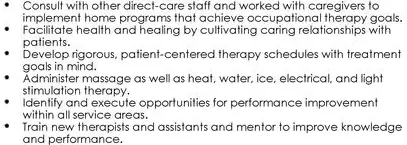
- Cultivating relationships with patients
- Identifying and executing opportunities for performance improvement
- Training new therapists
These are all unique experiences that this OT has had which differentiate him from competing job applicants.
Additionally, each of these experiences added value to the business he worked for.
It is resumes like this that stand out and will earn the OTR/COTA a job interview.
So, how can you create compelling resume content that shares your unique & value-added OT experience?
Start by asking yourself which of the following skills you’ve had to develop and use throughout your education and any job experience you’ve had:
- Planning/Organizing – Any skills that show you can plan and organize things like OT interventions, treatment plan adjustments, new facility processes, or new facility equipment and offerings
- Analytical/Research – Any skills that show your ability to analyze patients or research their conditions to improve their treatment results. Also, any research or analysis you’ve done on clinical processes, services, and equipment to improve treatment results should be noted.
- Process Improvement – Any skills that display your ability to improve processes that a clinic uses. Improvements can be in the form of increased: efficiency or production as well as decreases in: costs, customer frustrations, or use of other clinical resources.
- Taking initiative – Any time you have taken initiative and gotten results, you want to showcase this on your resume. This is a big one all employers are looking for.
- Leadership (with colleagues and patients) – Any time you’ve displayed leadership among co-workers and/or patients it should be noted on your resume.
- Critical Thinking – Critical thinking skills that you’ve demonstrated to assist your patients and help improve a clinic should be highlighted.
- Problem Solving – Any time you’ve been presented with a difficult problem and you solved it successfully you want to communicate this on your resume. Believe it or not, a lot of employees identify problems without offering solutions which just creates headaches for employers. Show them that you solve these problems reducing headaches and you’re basically hired.
- Interpersonal Communication (With clients, families, and colleagues) – Licensed OTR and COTA professionals know how important interpersonal communication skills are to get the job done right. It is essential that you demonstrate on your resume your experience and ability to communicate with clients, patient families, co-workers, both inferiors and superiors.
As you read that list and think of experiences that you’ve had where you have exhibited these skills, take notes.
These are the experiences that you will want to highlight on your resume.
Out of all of the occupational therapy resumes that we’ve seen, the most common element they are missing is highlighted accomplishments distinguishing the OT professional as an employee adding value.
So, this is a big opportunity to make your OT resume stand out!
Now, let’s go over some more good examples of OT resume content and exactly how you can incorporate them into your resume.
Back to Top
Education and Work Experience Section – Your OT Accomplishments!
All of your accomplishments, or unique value-added experiences, will be listed on your resume in the education and work experience section.
The following are good examples of the types of accomplishments in occupational therapy that you would highlight on your resume:
- Process improvement is a great thing to highlight on your resume as this creates huge value for businesses. Make sure you present the highlight with a solid adjective like “Improved”, “Implemented” or “Enhanced” rather than just “Used” and don’t forget to include any results such as decreased costs.
- Any coaching, training, educating, or leadership roles that you have assumed should always be listed to display your management, communication, and leadership skills. Relevant educational accolades should be presented as well.
- Anytime that you take initiative and lead a successful project both the initiative and success should be highlighted on your resume.
- I think it is obvious why you should highlight accomplishments where you increase the productivity of a clinic. This is a clear statement of how you have successfully added value for an employer.
- If you have experience working with, or focused on, a specific demographic of patient (Ie: age, gender, or disorder) then it is important to include this highlight when applying for a job that would require skills working with said demographic.
- If you have done something like the above that creates value for the employer in the form of increased referrals, then you definitely want to include this highlight in your resume. Again, I hope that some of these examples seem somewhat obvious.
- Anytime you receive positive feedback from a professor, colleague, supervisor, or patient you will want to highlight this positive feedback on your resume. This is also a great resume highlight as it shows a bit of your personality, creativity, and passion that you bring to your job.
The above examples should get your brain ticking.
Now, think back to your fieldwork or last job. Ask yourself the following:
- What did you do best?
- Or, another way to look at it, how did you add the most value for:
- The employer?
- Your patients?
- Your colleagues?
Start writing down your answers, they will make great resume content.
Back to Top
Additional and Special Skills Section
There are thousands of other occupational therapy professionals with 1, 3 or 5+ years experience. So, simply presenting yourself as an OT with x years experience won’t cut it.
Most resumes have a section, typically just below where your education and work experience is listed, that is for listing any special or additional skills you may have.
This can include things like specific types of conditions or patients you assisted, treatments/interventions you delivered, specific demographics you served (pediatric vs geriatric) or even software that you used at the clinic.
Use this section to clearly and concisely express your unique and powerful skill set.
Shoot for about 3 – 5 powerful and concise phrases describing your skill set, things like:
I have very strong skills using Ecare and have been successful in charge of managing all clinical data.
My love for children has led me to create many successful custom pediatric intervention plans.
My own experience taking care of my grandmother with dementia led me to excel at working with dementia patients.
These statements are unique, descriptive, powerful, and concise. You should be able to come up with at least 3 similar statements about yourself.
These examples are also full of great keywords and tell the applicant’s story. Which leads us to our final resume tips.
Final Resume Tips for Getting Hired
You’ve learned just about everything you need to crush your OT resume and land an awesome job.
But there are a couple more pro resume tips that we can share to help your resume get more visibility by recruiters and selected for more interviews.
If you have already created your resume then read this tips and then review your resume for opportunities to implement them.
Otherwise, be thinking of these tips as you write your resume content.
Keywords for Submitting Resumes Online
When submitting your resume to services online such as CareerBuilder it is important to understand that they will be scanned by software before being distributed to humans.
So you must think of keywords that recruiters would tell the software to collect resumes for.
Then you must include these keywords in your resume so that the program will find your resume for recruiters, getting you more visibility.
Common terms like “therapy” “treatment” and “interventions” will be on everyone’s resume so they won’t be words that recruiters will be using to find resumes.
You will want more descriptive terms like “autistic” “sensory processing disorders” “home health” and “pediatric” because these are terms that recruiters will be searching to find resumes that meet their job requirements.
Just make sure you use your keywords naturally through your resume content, placing them in sentences like this:
“Led first successful research, planning, and build of sensory gym for an autism care facility’s sensory processing disorder program.”
You won’t want to have a keyword section with a bullet point list of keywords. It is best practice to use them throughout your resume content where it makes sense to use them.
Here are some more examples of good keywords that you can use in your resume:
- Pediatric
- Geriatric
- Autism
- Sensory Processing Disorder
- Alzheimers
- Dementia
- Home Healthcare
- Acute Care
- Skilled Nursing Facility
- Ecare
- Sigma Care
- School
- Children
- learning disability
- mental health
Pepper those keywords into your powerful resume statements and you will get your resume in more recruiter’s hands.
Tip 1: Go to Google and search ‘submit resume free’ or something similar to find more sites like CareerBuilder where you can list your resume for recruiters to review.
Tip 2: In addition to submitting your resume for recruiters to find, you can also apply directly to job postings.
If you find a job you want to apply for, copy the job description and then go to jobscan.co where you can paste it. You will also paste in your resume contents and then the software will give you tips on optimizing your resume for that specific job posting.
Ok, so to wrap up this section, no need to go overboard on keywords. But make sure that the most descriptive and important keywords are incorporated throughout your resume.
You should also consider using a tool like jobscan.co, or doing your own manual review, to check and make sure your resume has your keywords and is tailored to each job you apply too.
Your Resume Should Tell your story
Our final piece of resume advice is simple, tell your story.
After all, being authentic is the best way to get matched with a job and employer that will be the best fit for you.
And the most authentic resumes tell the applicant’s story.
Your resume should be your unique story told in a clear, powerful, and concise document so that an employer can quickly get to know the person they would be entrusting their business too.
If throughout your education and career you were the innovative COTA always suggesting process and equipment updates based on new trends in OT, then use your resume to tell this story.
If you were the leader who got study groups together in school, trained your colleagues during clinical trials, or grew the practice you previously worked in, tell these stories throughout your resume.
If you’re a mom who loves children and this improves your job skills. Or you grew up taking care of your grandparent with alzheimers, making you exceptional with dementia patients. Then tell these stories.
By including just a short bullet point that introduces these stories, you will entice the recruiter to want to interview you so that they can ask for all the details behind that bullet.
Obviously you won’t have room in your resume to share all the details of your story. But introduce your story through your resume and earn the opportunity to share the details in an interview.
Back to Top
Conclusion
In conclusion, here is how you can create an effective resume to get hired for the job you want:
- Download our free occupational therapy resume template.
- Fill it out and focus your content on your unique experiences which add value to a business.
- Do this in a way that tells your story and depicts your unique skill set.
- Review to make sure you incorporated important keywords recruiters are looking for.
- Submit resume to online job sites and local job postings.
- Get hired.
Now go crush your resume and land your dream job in occupational therapy!
Once you finish your resume, use our OTA Salary Database to find the highest paying cities as you being looking for awesome job opportunities in occupational therapy.
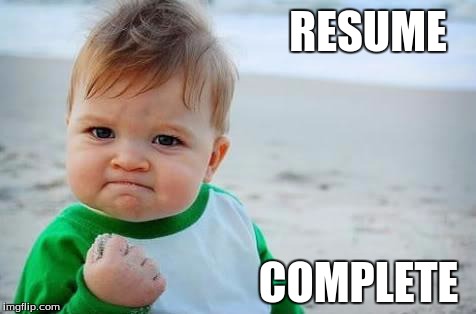
If you would like to download more awesome resume templates, then checkout http://www.resumeshoppe.com/. They created the template that we gave away in this post and they have lots of awesome and professional resume templates.
Have questions about your resume or finding a job? Or some insight for job seekers?Then please drop a comment below! 🙂

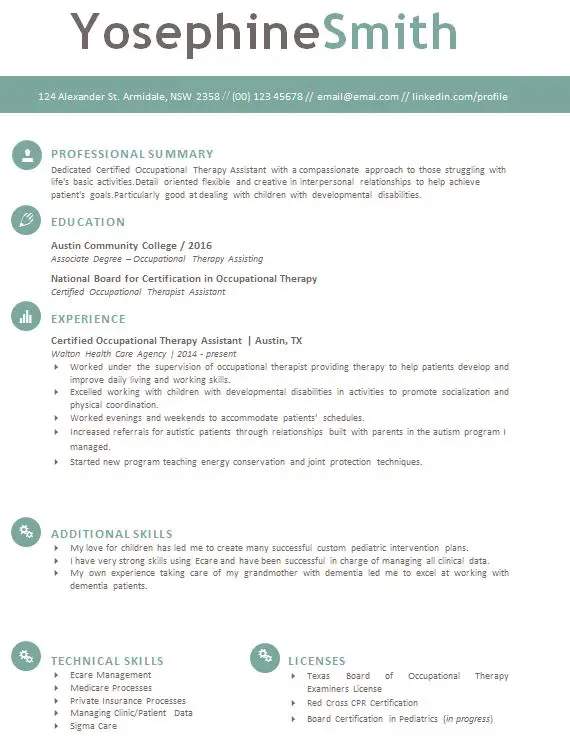
Would like to know if anyone has had any experience with online schools for OTA training including Masters level
Thanks
Hi Kathleen, thanks for your comment. Check out this resource and let me know what specific questions you still have about studying online.
https://occupational-therapy-assistant.org/online-ota-programs/
Hope that helps 🙂
Excellent article.This is the template I’ve been searching for months. Love it
So happy to hear that, Lisa! Have a great weekend 🙂